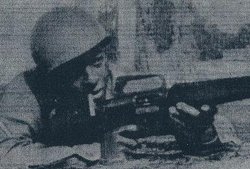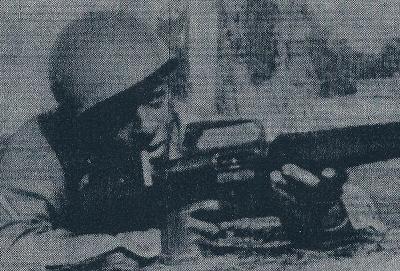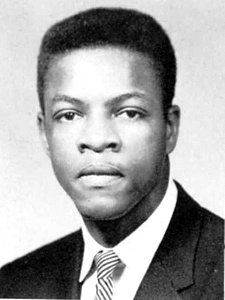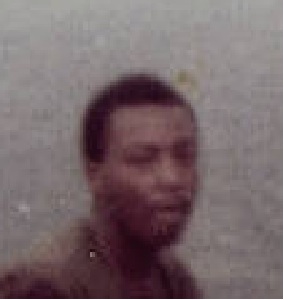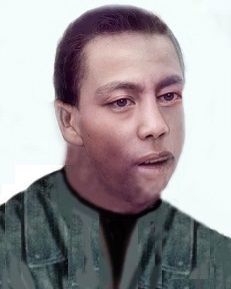*** AMERICAN POWs IN SOUTHEAST ASIA WHO ESCAPED CAPTIVITY -
USA S. Vietnam AIKEN, LARRY DELARNARD E4 13 MAY 1969 10 JUL 1969.
You may be gone, no longer living on this earth; but you will live on - in the memories of your family and friends. There will always be a part of you living in your family and those who knew you and loved you. You will live on because we remember you!
LARRY DELARNARD AIKEN - Army - SP4 - E4
Age: 20
Race: Negro
Date of Birth Dec 24, 1948
Last Place of Residence: Prince George's, Maryland
From: JAMAICA, NY
Religion: BAPTIST
Marital Status: Single
***** To my uncle, you are missed, I always remember, running, down the block, to your waiting arms. you are always, at our family, gatherings.
love ya, gwennie
Gwen Jones
Dale City, Va.
***** Larry Aiken was my cousin. I've always been afraid to go to the actual wall. Today, I finally got the nerve to look for his name on the internet. I was 15 years oldwhen he died at 20. When he was 15 he used to pick my little brother up from daycare for my mother, everyday, because the minimum age, for that was 12 and I was to young. I remember that Larry was handsome, friendly and sweet, to young and old. We both had parents from South Carolina and Larry had those respectful manners, that parents, from that time and place instilled in their children. Larry's brothers told me he was missing in action in Nam, so I thought, that meant he was dead and they did not know where to find his body. I did not know he was a POW. until the rescue. I remember when he was rescued, there were headlines in all the New York papers, (there were a lot more papers then) announcing the rescue and saying that Larry was deliberately wounded by his captors at the time of the raid. I was shocked to find he had been a prisoner all that time. I loved my cousin. I looked up to him and I have fond memories of him. The comments of Sgt., Bliss, based on the book, "The Raid," "that SP4, Larry Aiken was the ONLY POW. to be freed during a recovery attempt during the Viet Nam War," were a revelation to me. I DID know he was wounded in such a way that he did not survive. I had forgotten that he lived 15 days, but I remembered we were hoping he would come home, only, to have his widowed mother, have, to wait weeks more before they sent his body home. She said, they took him away quickly, but it took a long time to get him back. His mother told me a little, about the type of injuries the military said he had.
Gloria Creech
Cousin
Far Rockaway, NY., 11691
***** Aiken, We started our journey together back in June, 1968. It continued through to when we received our orders. The picture I took of you in AIT., came back to tear at my heart and soul. The three of us, you, Bates and myself, parted, to the three different Battalions, of the 196th. We kept in touch sporadically, through letters and I saw you, for a short time in passing during a "Stand Down." Looking back, it now seems quite prophetic on your part. You told me, that you didn't think that you were going to make it. I didn't want to hear that and told you that you were. During my convalescence in the 249th, Gen. Hosp., I picked up an issue of Stars and Stripes and I see that picture I took. You didn't. I'm so sorry. I'm blessed to have known you in that short time. Your were "good people" and we have suffered a loss. You will be with me always.
Jerry Johnson, Jr
SP4 - E4 - Army - Selective Service
196th Light Infantry Brigade
Length of service 1 years
His tour began on Nov 9, 1968
Casualty was on Jul 25, 1969
In QUANG TIN, SOUTH VIETNAM
Hostile, died of wounds, GROUND CASUALTY
OTHER CAUSES
Body was recovered
Panel 20W - Line 42
Other Personnel in Incident: The ten men killed in the engagements were
• A Company: ◦ SFC Domingo F. Morado, San Antonio, TX
◦ SP4 David F. Bukowski, West Islip, NY
◦ CPL Teddy R. Moore, Shinnston, WV
• C Company: ◦ SP4 Martin L. Damitio, Olympia, WA
◦ PFC John V. Folger, Bayonne, NJ
◦ PFC Jerome K. Lukas, Caledonia, MI
◦ PFC Francis G. Patton, Upper Darby, PA
◦ PFC Alan C. Ward, Cincinnati, OH
• D Company: ◦ PFC Raymond L. Williams, Alexandria, VA
• HQ Company: ◦ SP4 Felix G. Gonzales, Luling, TX (medic)
2007 PMSEA - changed the status of Aiken from EE to a new status of RR.
REMARKS: 790710 RECOVERED FROM VC HOSPITAL
SYNOPSIS: The records of the millions of U.S. servicemen in Vietnam are so extensive that errors and inconsistencies were bound to occur occasionally. The same is true of those men who are missing, prisoner or otherwise unaccounted for.
The case of Cpl. Larry D. Aiken is one example. Aiken, a negro, is listed as missing on May 13, 1969. Intelligence later revealed that he had been captured, but "recovered" by unnamed individuals from a Viet Cong hospital. Thus, on lists compiled which showed the status of each missing
American in 1973, Aiken was listed as a released POW.
At some point between 1973 and 1980, however, additional information must have been received as Aiken's status was changed to escaped POW. Currently, Defense Intelligence Agency classifies Aiken as a returned POW.
Because Aiken's name does not appear on many of the lists of returned POWs, many POW/MIA activist groups maintain his name on file as one on whom insufficient information is available. These groups are aware that even one
man could easily be forgotten because of clerical errors.
As reports mount that indicate Americans are still alive, POW/MIA groups work harder to be sure that not a single man is forgotten.
02/98
Another version of what might have happened to Larry Aiken can be found on pages 237 and 238 of Benjamin Schemmer's "THE RAID", published by Avon. It states:
Son Tay was not only not the first rescue attempt, in Southeast Asia in this conflict. It was, in fact, the 71st "dry hole." In South Vietnam, Cambodia, and Laos such rescue operations were mounted between 1966 an 1970. At least 45 of them, probably closer to 50, were triggered by reports of U.S. POWs. Seventy-nine of the operations involved outright "raids." Of the 91 rescue operations, 20 succeeded-in rescuing 318 South Vietnamese soldiers and 60
civilians. But of 45 raids mounted to rescue American prisoners, only one succeeded. Army Specialist Fourth Class Larry D. Aiken was rescued on July 10, 1969, from a Viet Cong POW camp, but he died in an American hospital 15
days later of wounds inflicted by his captors just before his rescue. The raid, apparently, had been compromised at the last minute.
All of the rescue missions before Son Tay had been handled within the Joint Personnel Recovery Center (JPRC), a separate staff section within MACV Headquarters in Saigon. The results of the JPRC's efforts were no less
heartbreaking than the raid on Son Tay. In December of 1966, for instance, a confidential informant passed word of American prisoners being held by the Viet Cong. The JPRC found his information credible and launched a raid.
There was a heavy fire fight in which 35 Viet Cong were killed and 34 others detained. During interrogation, they confirmed that Americans had been held in the camp. The prisoners had been moved just before the raid.
Some of the JPRC's raids failed because intelligence was compromised, others because the rescues weren't launched quickly enough. This happened on one raid in 1967 when a South Vietnamese escapee from a Viet Cong POW camp
reported the location of two camps containing American prisoners. His report was challenged at first, then finally verified. A raid was launched, and at one camp, 21 South Vietnamese prisoners were recovered. The other
camp was empty. Yet evidence showed that American POWs had been there. The released South Vietnamese POWs said that the Americans had been moved about 30 days before the raid, after the escapee first reported the presence of
American prisoners there.
After Aiken's 1969 rescue, efforts to find POW camps and free prisoners in South Vietnam and Cambodia intensified.
In 1970 alone, 24 separate rescue operations were conducted in the south. They failed to unearth even the
remains of a single U.S. prisoner. The rescue missions continued even after the failure of the Son Tay raid. By 1973 such missions would total 119, including 98 raids. Aiken would remain the only American ever to be recovered.
***************************************************
Dramatic Vietnam, rescue recounted SAIGON ( A P ) --
A seriously' wounded American soldier missing in action for nearly two months, was rescued from enemy forces in a daring operation Thursday, the U.S. Command reported Saturday.
Spokesmen said Spec. 4 Larry D. Aiken, 20, of Jamaica, N.Y., was taken out by helicopter from a North Vietnamese camp near Tarn Ky, 350 miles northeast of Saigon, while a security force of American and South Aiken was unconscious during the rescue and has not regained consciousness at an Army hospital at Chu Lai, headquarters of the Americal Division.
Doctors said he was suffering from "an open skull fracture and brain damage."
His condition was listed as "very serious.' The 'U.S. Command said American officers learned of Aiken's whereabouts from an enemy soldier who defected to the south' Vietnamese 2nd Division.
They devised a rescue plan in which South Vietnamese Infantrymen and regional force troops made an air assault into en's company had come under the area to seize it, while two soldiers, a South Vietnamese and an American were lowered on ropes from a hovering helicopter to find Aiken.
The American, Pfc. Robert Bohler, of Austin, Tex., and the South Vietnamese trooper carried the unconscious Aiken to another helicopter which landed 300 yards away and lifted them out.
Aiken had vanished in May during an operation involving his unit, the 3rd Battalion of the 21st Infantry, 196th Light Infantry Brigade, west of Tam Ky.
The U.S. Command said Aikek wound, although it heavy small arms and rocket grenade fire after it came across an enemy position. "With five other members of his unit, Specialist Aiken was providing security in a rice paddy while his company maneuvered to its position," a U.S. Command report said.
"A later sweep of the area failed to locate Specialist Aiken. When last seen by his platoon leader he was moving and not wounded. A spokesman Saturday said it was not known exactly how or when Aiken suffered his head was the same day but not during the fight that occurred in connection with his rescue.
He said it was ' not known whether Aiken might have suffered the wound at the hands of enemy troops.
According to Army doctors it was not a gunshot wound. A command spokesman said today that it was not known how or 'when Aiken was wounded, although it was not during the res cue operation.
In addition to the six North Vietnamese killed during the rescue, three others were captured and three weapons were seized/the command said.
****************************************
.
*** AMERICAN POWs IN SOUTHEAST ASIA WHO ESCAPED CAPTIVITY -
USA S. Vietnam AIKEN, LARRY DELARNARD E4 13 MAY 1969 10 JUL 1969.
You may be gone, no longer living on this earth; but you will live on - in the memories of your family and friends. There will always be a part of you living in your family and those who knew you and loved you. You will live on because we remember you!
LARRY DELARNARD AIKEN - Army - SP4 - E4
Age: 20
Race: Negro
Date of Birth Dec 24, 1948
Last Place of Residence: Prince George's, Maryland
From: JAMAICA, NY
Religion: BAPTIST
Marital Status: Single
***** To my uncle, you are missed, I always remember, running, down the block, to your waiting arms. you are always, at our family, gatherings.
love ya, gwennie
Gwen Jones
Dale City, Va.
***** Larry Aiken was my cousin. I've always been afraid to go to the actual wall. Today, I finally got the nerve to look for his name on the internet. I was 15 years oldwhen he died at 20. When he was 15 he used to pick my little brother up from daycare for my mother, everyday, because the minimum age, for that was 12 and I was to young. I remember that Larry was handsome, friendly and sweet, to young and old. We both had parents from South Carolina and Larry had those respectful manners, that parents, from that time and place instilled in their children. Larry's brothers told me he was missing in action in Nam, so I thought, that meant he was dead and they did not know where to find his body. I did not know he was a POW. until the rescue. I remember when he was rescued, there were headlines in all the New York papers, (there were a lot more papers then) announcing the rescue and saying that Larry was deliberately wounded by his captors at the time of the raid. I was shocked to find he had been a prisoner all that time. I loved my cousin. I looked up to him and I have fond memories of him. The comments of Sgt., Bliss, based on the book, "The Raid," "that SP4, Larry Aiken was the ONLY POW. to be freed during a recovery attempt during the Viet Nam War," were a revelation to me. I DID know he was wounded in such a way that he did not survive. I had forgotten that he lived 15 days, but I remembered we were hoping he would come home, only, to have his widowed mother, have, to wait weeks more before they sent his body home. She said, they took him away quickly, but it took a long time to get him back. His mother told me a little, about the type of injuries the military said he had.
Gloria Creech
Cousin
Far Rockaway, NY., 11691
***** Aiken, We started our journey together back in June, 1968. It continued through to when we received our orders. The picture I took of you in AIT., came back to tear at my heart and soul. The three of us, you, Bates and myself, parted, to the three different Battalions, of the 196th. We kept in touch sporadically, through letters and I saw you, for a short time in passing during a "Stand Down." Looking back, it now seems quite prophetic on your part. You told me, that you didn't think that you were going to make it. I didn't want to hear that and told you that you were. During my convalescence in the 249th, Gen. Hosp., I picked up an issue of Stars and Stripes and I see that picture I took. You didn't. I'm so sorry. I'm blessed to have known you in that short time. Your were "good people" and we have suffered a loss. You will be with me always.
Jerry Johnson, Jr
SP4 - E4 - Army - Selective Service
196th Light Infantry Brigade
Length of service 1 years
His tour began on Nov 9, 1968
Casualty was on Jul 25, 1969
In QUANG TIN, SOUTH VIETNAM
Hostile, died of wounds, GROUND CASUALTY
OTHER CAUSES
Body was recovered
Panel 20W - Line 42
Other Personnel in Incident: The ten men killed in the engagements were
• A Company: ◦ SFC Domingo F. Morado, San Antonio, TX
◦ SP4 David F. Bukowski, West Islip, NY
◦ CPL Teddy R. Moore, Shinnston, WV
• C Company: ◦ SP4 Martin L. Damitio, Olympia, WA
◦ PFC John V. Folger, Bayonne, NJ
◦ PFC Jerome K. Lukas, Caledonia, MI
◦ PFC Francis G. Patton, Upper Darby, PA
◦ PFC Alan C. Ward, Cincinnati, OH
• D Company: ◦ PFC Raymond L. Williams, Alexandria, VA
• HQ Company: ◦ SP4 Felix G. Gonzales, Luling, TX (medic)
2007 PMSEA - changed the status of Aiken from EE to a new status of RR.
REMARKS: 790710 RECOVERED FROM VC HOSPITAL
SYNOPSIS: The records of the millions of U.S. servicemen in Vietnam are so extensive that errors and inconsistencies were bound to occur occasionally. The same is true of those men who are missing, prisoner or otherwise unaccounted for.
The case of Cpl. Larry D. Aiken is one example. Aiken, a negro, is listed as missing on May 13, 1969. Intelligence later revealed that he had been captured, but "recovered" by unnamed individuals from a Viet Cong hospital. Thus, on lists compiled which showed the status of each missing
American in 1973, Aiken was listed as a released POW.
At some point between 1973 and 1980, however, additional information must have been received as Aiken's status was changed to escaped POW. Currently, Defense Intelligence Agency classifies Aiken as a returned POW.
Because Aiken's name does not appear on many of the lists of returned POWs, many POW/MIA activist groups maintain his name on file as one on whom insufficient information is available. These groups are aware that even one
man could easily be forgotten because of clerical errors.
As reports mount that indicate Americans are still alive, POW/MIA groups work harder to be sure that not a single man is forgotten.
02/98
Another version of what might have happened to Larry Aiken can be found on pages 237 and 238 of Benjamin Schemmer's "THE RAID", published by Avon. It states:
Son Tay was not only not the first rescue attempt, in Southeast Asia in this conflict. It was, in fact, the 71st "dry hole." In South Vietnam, Cambodia, and Laos such rescue operations were mounted between 1966 an 1970. At least 45 of them, probably closer to 50, were triggered by reports of U.S. POWs. Seventy-nine of the operations involved outright "raids." Of the 91 rescue operations, 20 succeeded-in rescuing 318 South Vietnamese soldiers and 60
civilians. But of 45 raids mounted to rescue American prisoners, only one succeeded. Army Specialist Fourth Class Larry D. Aiken was rescued on July 10, 1969, from a Viet Cong POW camp, but he died in an American hospital 15
days later of wounds inflicted by his captors just before his rescue. The raid, apparently, had been compromised at the last minute.
All of the rescue missions before Son Tay had been handled within the Joint Personnel Recovery Center (JPRC), a separate staff section within MACV Headquarters in Saigon. The results of the JPRC's efforts were no less
heartbreaking than the raid on Son Tay. In December of 1966, for instance, a confidential informant passed word of American prisoners being held by the Viet Cong. The JPRC found his information credible and launched a raid.
There was a heavy fire fight in which 35 Viet Cong were killed and 34 others detained. During interrogation, they confirmed that Americans had been held in the camp. The prisoners had been moved just before the raid.
Some of the JPRC's raids failed because intelligence was compromised, others because the rescues weren't launched quickly enough. This happened on one raid in 1967 when a South Vietnamese escapee from a Viet Cong POW camp
reported the location of two camps containing American prisoners. His report was challenged at first, then finally verified. A raid was launched, and at one camp, 21 South Vietnamese prisoners were recovered. The other
camp was empty. Yet evidence showed that American POWs had been there. The released South Vietnamese POWs said that the Americans had been moved about 30 days before the raid, after the escapee first reported the presence of
American prisoners there.
After Aiken's 1969 rescue, efforts to find POW camps and free prisoners in South Vietnam and Cambodia intensified.
In 1970 alone, 24 separate rescue operations were conducted in the south. They failed to unearth even the
remains of a single U.S. prisoner. The rescue missions continued even after the failure of the Son Tay raid. By 1973 such missions would total 119, including 98 raids. Aiken would remain the only American ever to be recovered.
***************************************************
Dramatic Vietnam, rescue recounted SAIGON ( A P ) --
A seriously' wounded American soldier missing in action for nearly two months, was rescued from enemy forces in a daring operation Thursday, the U.S. Command reported Saturday.
Spokesmen said Spec. 4 Larry D. Aiken, 20, of Jamaica, N.Y., was taken out by helicopter from a North Vietnamese camp near Tarn Ky, 350 miles northeast of Saigon, while a security force of American and South Aiken was unconscious during the rescue and has not regained consciousness at an Army hospital at Chu Lai, headquarters of the Americal Division.
Doctors said he was suffering from "an open skull fracture and brain damage."
His condition was listed as "very serious.' The 'U.S. Command said American officers learned of Aiken's whereabouts from an enemy soldier who defected to the south' Vietnamese 2nd Division.
They devised a rescue plan in which South Vietnamese Infantrymen and regional force troops made an air assault into en's company had come under the area to seize it, while two soldiers, a South Vietnamese and an American were lowered on ropes from a hovering helicopter to find Aiken.
The American, Pfc. Robert Bohler, of Austin, Tex., and the South Vietnamese trooper carried the unconscious Aiken to another helicopter which landed 300 yards away and lifted them out.
Aiken had vanished in May during an operation involving his unit, the 3rd Battalion of the 21st Infantry, 196th Light Infantry Brigade, west of Tam Ky.
The U.S. Command said Aikek wound, although it heavy small arms and rocket grenade fire after it came across an enemy position. "With five other members of his unit, Specialist Aiken was providing security in a rice paddy while his company maneuvered to its position," a U.S. Command report said.
"A later sweep of the area failed to locate Specialist Aiken. When last seen by his platoon leader he was moving and not wounded. A spokesman Saturday said it was not known exactly how or when Aiken suffered his head was the same day but not during the fight that occurred in connection with his rescue.
He said it was ' not known whether Aiken might have suffered the wound at the hands of enemy troops.
According to Army doctors it was not a gunshot wound. A command spokesman said today that it was not known how or 'when Aiken was wounded, although it was not during the res cue operation.
In addition to the six North Vietnamese killed during the rescue, three others were captured and three weapons were seized/the command said.
****************************************
.
Inscription
SP4 CO C 21 INF
AMERICAL DIV
VIETNAM
BSM-PH
Family Members
Sponsored by Ancestry
Advertisement
Advertisement
